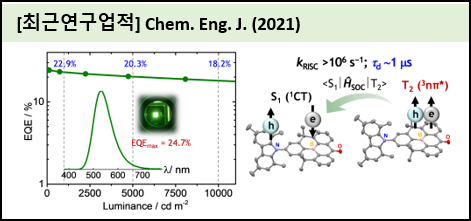|
Author list |
Lee, Young Hoon; Shin, Youn-Seob, Lee, Taehwan; Jung, Jaehoon; Lee, Jeong-Hwan; Lee, Min Hyung |
|
Abstract |
Improving the rate of a spin-flip process from a triplet to a singlet excited state, which is known as reverse intersystem crossing (RISC), is a challenging issue in realizing efficient and stable organic light-emitting diodes based on thermally activated delayed fluorescence (TADF-OLEDs). Herein, we report two donoracceptor-type TADF emitters (TMCzBCO and DMACBCO) employing a boron-carbonyl (BCO) hybrid acceptor unit. The emitters possess a 3n* state of the BCO unit as an intermediate local triplet excited state (3LE, T2), leading to the large spin-orbit coupling between the T2 and excited singlet (S1) states with significantly low activation barriers less than 10 meV. Thus, a fast RISC with rate constants (kRISC) exceeding 106 s-1, as well as short exciton lifetimes (1 s), are realized. Using the TADF emitters, high-performance TADF-OLEDs with maximum external quantum efficiencies of 24.7% for the green (TMCzBCO) and 28.4% for the yellow (DMACBCO) are presented. Remarkably, the devices sufficiently maintain high efficiency at high luminance, exceeding 20% at 5,000 cd m-2 and 18% at 10,000 cd m-2. These results indicate the crucial role of the 3n* state of BCO in the improvement of the RISC rate and shortening of the exciton lifetime, enhancing the optoelectrical performance of TADF-OLEDs. |

